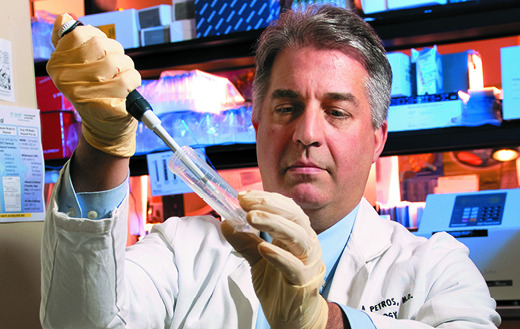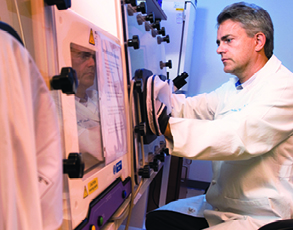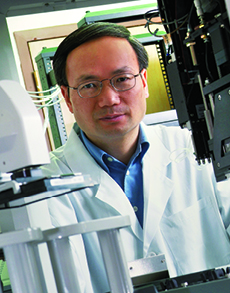Believing in cures, transforming lives

John Petros, MD, and colleagues have developed a test to detect and better understand the role a retrovirus called XMRV has in prostate cancer.
Why do some people get cancer? How can we detect it before it spreads? How can we cure cancer—or convert it into a chronic, manageable disease? Better yet, how can it be prevented? No place in Georgia takes a more collaborative, more aggressive approach to finding the answers to these questions. No place gets findings more quickly to patients.
|
Tracking who, when, and how effective, one patient at a time No place in Georgia has stronger cancer research partners than Winship |
Tracking who, when, and how effective–one patient at a time
As many as half of lung cancers have genetic changes or mutations, a finding that led to new therapies that are more effective and have less toxicity than chemotherapy — but only for patients with specific genetic changes. The question now is how best to identify patients who would most benefit from these therapies (and provide other targeted therapies to other patients). With the permission and support of many patients diagnosed with advanced lung cancer, Winship is one of 14 cancer centers helping identify, fingerprint, and catalog genetic changes in order to hasten the implementation of truly personalized medicine for lung cancer.
In another study, funded by the Department of Defense, Winship Radiation Oncology researchers are developing new imaging technology that will tell non-small cell lung cancer patients within days if a chemotherapy or radiation therapy treatment is likely to work. That would allow critical decisions to be made early, when the cancer is more treatable.
Searching lymph node tissue for the cells that indicate Hodgkin’s lymphoma is like looking for a needle in a haystack. Yet when the quantum dots developed by Emory and Georgia Tech scientists are chemically linked to proteins on cancer cells, the dots pick out the cancer cells easily. Furthermore, the methodology allows pathologists to look at more than one protein at the same time, requiring smaller biopsies and thus minimizing the burden on the patient.

Erwin Van Meir, PhD, works to find new targeted treatments in brain, lung, and ovarian cancers by researching DNA alterations. |
Winship researchers have developed a clinical test for a retrovirus (xenotropic murine leukemia virus-related virus, or XMRV), recently found in some prostate cancer patients. Little is known about how the virus is transmitted, and no method has existed to screen blood or tissue donors for possible infection. The Emory technology, adapted from HIV antibody assays, makes it possible to do just that — and to answer important questions about the virus’s role in prostate cancer. In a separate study, Emory and University of Utah researchers found that four drugs currently approved for treating HIV also can inhibit XMRV.
Stopping cancer in its tracks
When cancer cells outgrow their blood supply, the low oxygen level drives the cells to send out signals to encourage new blood vessel growth. Winship researchers identified a chemical, the compound KC752, which throws a monkey wrench into the cells’ machinery for responding to low oxygen conditions. This inhibits growth of new vessels, causing cancer cells to suffocate and die — and suggests new types of treatment for many solid tumors.
|
Research is the wellspring of Winship’s “can do” attitude. Only through research can effective treatments be developed to help end cancer – and its devastating effects on patients and families. |

Professor of pharmacology Haian Fu, PhD, is studying how to attack lung cancer by silencing certain genes. |
Winship and Georgia Tech researchers have developed gold nanoparticles small enough to enter cells and smart enough to home in on head and neck cancer cells. Then, when exposed to a laser beam of a specific wavelength, these nanoparticles convert the energy to heat, killing the cancer cells while sparing healthy ones. In another study, magnetic iron oxide nanoparticles developed at Winship are loaded with chemotherapeutic agents, which they release near or inside pancreatic tumors, one of the most deadly of all cancers. In a third study, a team in Emory’s Brain Tumor Nanotechnology Laboratory use iron oxide nanoparticles in mice to bind to and kill implanted cells of glioblastoma multiforme, the most common and most aggressive primary brain tumor in humans, without toxicity to normal brain cells.
Winship brain tumor researchers developed a method using nanoparticles embedded with different antibodies to find proteins secreted by brain tumors in the cerebrospinal fluid, a much less invasive process than drilling in the brain. Imaging can tell clinicians a tumor is present, but seeing which anti-bodies are attracted to it reveals the tumor’s biology. The brain tumor program also is participating in the NIH Cancer Genome Atlas, cataloguing DNA alterations in brain, lung, and ovarian cancers with the goal of finding new treatments.
Complete removal of a tumor is the single most important predictor of patient survival for most solid tumors. That’s why Winship researchers and colleagues at Georgia Tech and the University of Pennsylvania developed a hand-held device called a SpectroPen that uses a near-infrared laser to help surgeons visualize the precise edges of tumors during surgery. Clinical trials are expected to begin soon.



